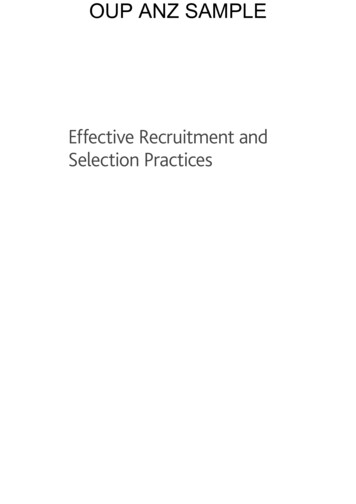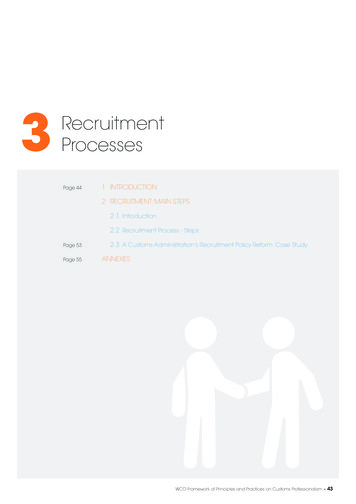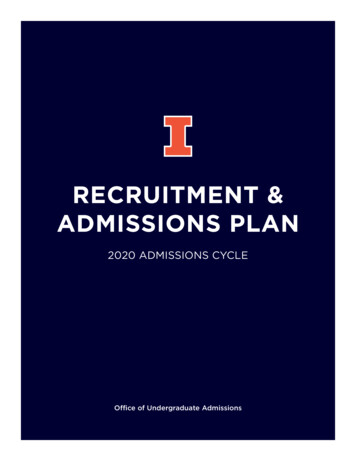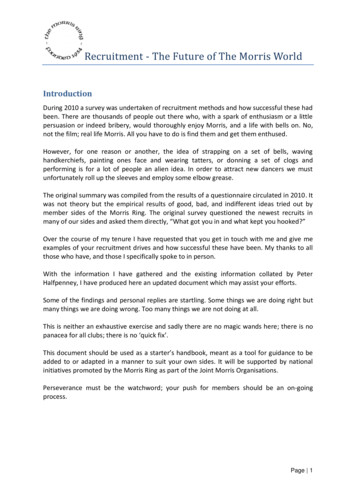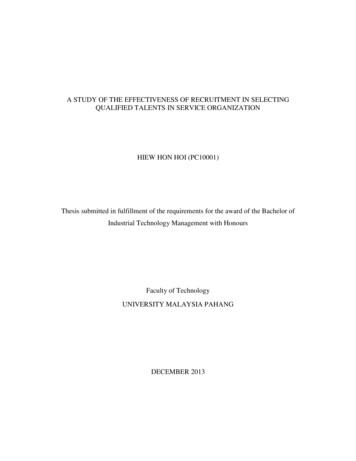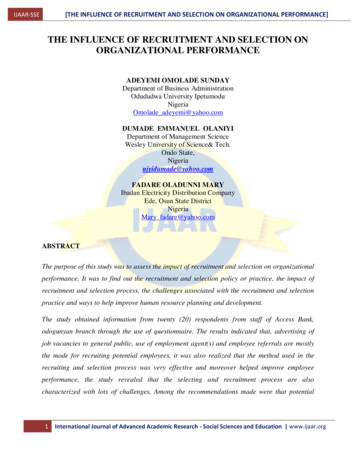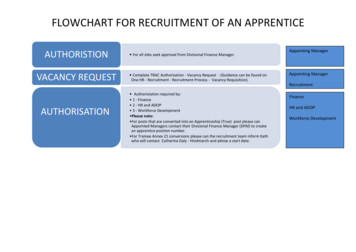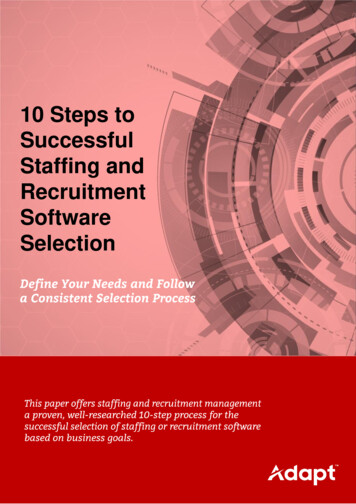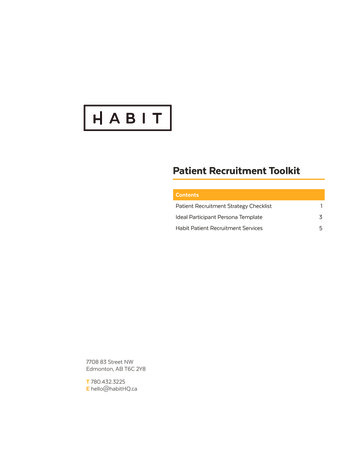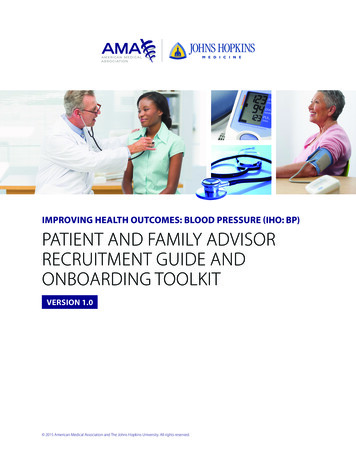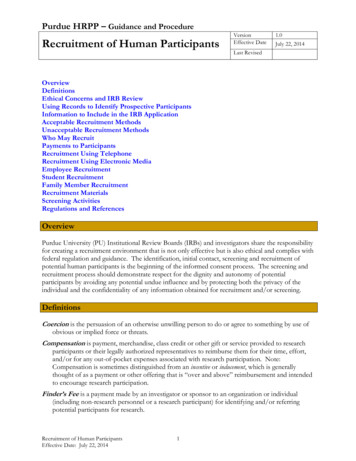
Transcription
Purdue HRPP – Guidance and ProcedureRecruitment of Human ParticipantsVersionEffective Date1.0July 22, 2014Last RevisedOverviewDefinitionsEthical Concerns and IRB ReviewUsing Records to Identify Prospective ParticipantsInformation to Include in the IRB ApplicationAcceptable Recruitment MethodsUnacceptable Recruitment MethodsWho May RecruitPayments to ParticipantsRecruitment Using TelephoneRecruitment Using Electronic MediaEmployee RecruitmentStudent RecruitmentFamily Member RecruitmentRecruitment MaterialsScreening ActivitiesRegulations and ReferencesOverviewPurdue University (PU) Institutional Review Boards (IRBs) and investigators share the responsibilityfor creating a recruitment environment that is not only effective but is also ethical and complies withfederal regulation and guidance. The identification, initial contact, screening and recruitment ofpotential human participants is the beginning of the informed consent process. The screening andrecruitment process should demonstrate respect for the dignity and autonomy of potentialparticipants by avoiding any potential undue influence and by protecting both the privacy of theindividual and the confidentiality of any information obtained for recruitment and/or screening.DefinitionsCoercion is the persuasion of an otherwise unwilling person to do or agree to something by use ofobvious or implied force or threats.Compensation is payment, merchandise, class credit or other gift or service provided to researchparticipants or their legally authorized representatives to reimburse them for their time, effort,and/or for any out-of-pocket expenses associated with research participation. Note:Compensation is sometimes distinguished from an incentive or inducement, which is generallythought of as a payment or other offering that is “over and above” reimbursement and intendedto encourage research participation.Finder’s Fee is a payment made by an investigator or sponsor to an organization or individual(including non-research personnel or a research participant) for identifying and/or referringpotential participants for research.Recruitment of Human ParticipantsEffective Date: July 22, 20141
Recruitment Bonus is a payment, merchandise, or other gift or service offered by an investigatoror sponsor as an incentive or reward to an organization, investigator or key personnelconducting research designed to accelerate recruitment that is tied to enrollment rate, timing, ornumbers.Recruitment Database is a data set including private identifiable information collected for thespecific purpose of identifying and recruiting potential participants.Recruitment Materials are announcements; advertisements; flyers; posters; scripts for telephone orother oral communication; letters and email messages; bulletin board tear-offs; internet postings;newspaper, radio, television, or video broadcasts, or other media used to attract potentialparticipants for research.Recruitment Methods are materials, incentives, and other practices or procedures used to informpotential participants about research.Student Subject Pools are usually comprised of undergraduate students enrolled in particularcourses requiring participation in one or more research projects (i.e., PSY 12000). Occasionallycolleges or departments create subject pools to communicate research opportunities to students.Undue Influence/Undue Pressure is excessive or inappropriate reward or other incentive inwhich a person is induced to act otherwise than by their own free will or without adequateconsideration of the consequences.Ethical Concerns and IRB ReviewThe IRB reviews the recruitment methods and materials for all studies in consideration of thepurpose of the research, the setting in which the research will be conducted and participantpopulation. Investigators should consider the following ethical issues when planning theirrecruitment strategies. These are the same considerations the IRB uses to evaluate studies. Equitable selection of participants: The recruitment plan ensures the selection of researchparticipants is equitable and appropriate for the study. Respect for persons: The recruitment plan ensures appropriate procedures are used for thestudy population, especially if the population presents any special problems requiring specificsafeguards. Such populations may include vulnerable populations such as children, prisoners,pregnant women, economically disadvantaged persons and cognitively impaired persons or thoselacking of decision-making capacity. Other populations (e.g., employees, students, etc.) may beconsidered a vulnerable population depending on their circumstances in relation to the research. Lack of pressure: The study is introduced to potential participants in a way that allows themample time to consider, with no undue pressure because of the timing of the request, whomakes the request, how the request is made, or the offering of excessive inducements. Considerif adolescents whose parents give them permission to be in the study will feel they cannot say“no”. Will students be hesitant to say “no” to a professor or teacher? Will employees be placedin a situation where they may be hesitant to say “no” to an employer or manager? How willsuch pressure be minimized? Respect for privacy: Recruitment plans should respect an individual’s reasonable expectationsfor privacy. Will potential participants identified using confidential information such as school,employee or patient records, have given permission beforehand for this use of theirRecruitment of Human ParticipantsEffective Date: July 22, 20142
information? If investigators ask screening questions, will the questions be asked in a privatesetting where others will not overhear the answers? Unbiased presentation: All information used for recruitment should be accurate, balanced,and free of misleading emphases that make the study excessively attractive. Is the information ascomplete as is appropriate for each stage of recruitment? The “Therapeutic Misconception”: Patients tend to believe anything proposed by healthcare providers will benefit them, even if they are told there is no assured benefit. This“misconception” can also affect the decisions of individuals participating in social, behavioraland education research. This misconception can occur any time participants believe that theywill directly benefit from participation in a research study, even if they are told there is noassured benefit. Does the recruitment plan work to counteract this misconception?Using Records to Identify Potential Participants The review of student records for the purpose of identifying, contacting and recruitingparticipants is subject to the rules set forth in the Family Educational Rights and Privacy Act(FERPA). See HRPP Policy Research Involving Student Education Records. Use of medical records for the purpose of identifying, contacting and recruiting participants issubject to HIPAA regulations. Access to medical records and identifiable health information bypeople not directly involved in a patient’s care is highly restricted. Use of Personally Identifying Information (PII) should limit the amount of identifiableinformation gathered or obtained and the number of people who have access to identifiableinformation must be minimized.Information to Include in the IRB ApplicationThe IRB needs to understand the details of all recruitment activities that will be used in a study. TheIRB application must reflect all of those activities and their related details. Below is a list ofquestions often asked of investigators about their studies. This list is not exhaustive nor do all ofthese questions pertain to every study. Nevertheless, even when relevant, IRB applicationsfrequently lack these pertinent details. Including a complete description in IRB applications goes along way towards helping investigators avoid delays in the IRB review process. If your IRB application proposes multiple study populations, address all applicable questions foreach participant group. An example of this is a study in which both students and their teachersare research subjects. Another example would be a study in which both teenagers and theirparents are research subjects. How will potential participants be initially identified for this study? Who will identify them? How and when will potential participants be approached/contacted about study participation?Who will conduct these activities and where will they occur?Recruitment of Human ParticipantsEffective Date: July 22, 20143
If your recruitment plan involves contacting individuals multiple times in an effort to securetheir initial enrollment in the study, describe how frequently and in what manner individuals willbe contacted. Identify all recruitment methods that will be used. If your recruitment plan involves using anyemail, address and/or telephone lists, how will those lists be obtained? Describe any provisions to protect the privacy and/or confidentiality of potential participants?This is particularly important when conducting research on sensitive topics, health-related issues,controversial issues, etc. Such provisions are as simple as sending a recruitment letter in anenvelope rather than sending a post-card or, if recruiting students in a K-12 school, the schoolmay send recruitment materials to parents rather than giving investigators access to their contactinformation. Will you use screening procedures? If so, who will conduct the screening procedures? Will you collect any information/data from potential participants during the recruitment and/orscreening process? How will it be collected (i.e., what procedures will be used)? Identify all datapoints that will be collected prior to their enrollment in the study. Will any identifying data collected during the recruitment and/or screening process be retainedwithout consent from individuals who failed to qualify for, or declined to participate in, thestudy? If yes, identify all retained data points and provide a justification for the retention. If not,will those data be destroyed and how will they be destroyed?Acceptable Recruitment MethodsThe following methods of recruiting subjects are generally acceptable. In reviewingrecruitment activities, the IRB reviews the mode of communication as well as the content and how itis presented. There may be circumstances in which one or more of the methods may not beappropriate for a particular study. This is not an exhaustive list but it is an outline of the mostcommonly used methods for recruitment and includes both behavioral and biomedical recruitmentstrategies. One study may employ more than one method of recruitment. The method(s) ofrecruitment should be discussed in the IRB application. Advertisements, flyers, information sheets, notices, internet postings on electronicbulletin boards and/or web pages. The text of these needs to be included within or as anattachment to the IRB Application. The IRB must approve the text to be used. Prospectiveparticipants who respond to these will contact the study investigators directly. See theRecruitment Materials section of this guidance for suggested text for ads and notices. Direct contact with potential study participants. Study team members may directly contactpotential participants either in person (face-to-face), by giving a presentation to a group, over thephone, or on the internet through chat rooms or instant messaging. Considerable care must betaken when using any of these methods so that the person contacted does not feel pressured toparticipate. Recruitment letters and/or emails. Ideally the recruitment letter or email would come fromsomeone or some agency or clinic known to the prospective participant informing them aboutRecruitment of Human ParticipantsEffective Date: July 22, 20144
the study. Preferably, the letter or email would ask the person to call for additional information,return a post card or send an email if interested in participating in the study.The recruitment letter or email can be brief but it should include: information about how the person was identified to be sent the letter, who is doing the study and why, what is involved if the person participates, an overview of any risks or potential benefits, information about how to contact the study team if interested in participating, where to get answers to additional questions, and when using email, proper notification about the confidentiality issues associated withemail communication. Random or other probability sampling. This could include snowball sampling, random digitdialing, or other methods used primarily in the social and behavioral sciences. Referrals. Referrals may be from non-investigator healthcare providers, snowball sampling,participants referring other participants. Investigators may provide their colleagues with a “DearPotential Study Participant” letter describing the study. Or researchers may provide informationsheets to colleagues or associates who can pass them on to potential participants. Participant pools. These are pools for which potential research participants have givenpermission for future contact. Another IRB-Approved Screening Protocol, Recruitment Protocol and/or RecruitmentDatabase. This protocol describes how potential research participants will be asked for and willgive permission for future contact. Investigators contact these potential participants aboutparticular studies according to their approved protocol and the consent of the prospectiveparticipant. In many cases prospective participants will have given permission to be contactedfor future studies by means of a check-off box in a consent form for a previous study. Review of medical records to identify potential research participants. Such proceduresmust be conducted in accordance with HIPAA requirements. Review of education records. Such procedures must be conducted in accordance withFERPA requirements. Review of publicly available records. Review of other records. Such procedures must be conducted in accordance with applicablerules and regulations.Unacceptable Recruitment Methods Use of Incentives, Finder’s Fees or Bonuses of any type in exchange for referral of potentialparticipants or tied to the rate or timing of enrollment is prohibited. Such payments mayencourage recruiters to put inappropriate pressure on prospective participants.Recruitment of Human ParticipantsEffective Date: July 22, 20145
Sharing of Participant Names and Contact Information: Researchers may not share namesand/or contact information of previous research participants with other researchers withoutpermission from those participants. Medical Record Access: When protected health information is involved, investigators who arenot the health care providers or part of the clinic providing health care are prohibited fromhaving access to patient names, addresses, phone numbers, medical record numbers or any otherform of protected health information. Patients must initiate contact unless there is documentedpermission from the patient (i.e., a note in the medical record that the primary care providerspoke with the patient who agreed to be contacted) that the patient agreed to be contacted. Student Education Records: Use of identifiable student education records other thandirectory information for research purposes without either the student’s consent (or parent’sconsent if student is under age 18) or receipt of an exception to FERPA granted by the RecordsCustodian of the institution owning the records, is prohibited.Who May RecruitProspective research participants should be contacted by someone who is Thoroughly knowledgeable about the study, Able to answer questions, Trained in the voluntary nature of research participation, and The most appropriate person to contact prospective participantsWhen treatment or medical care is involved, first contact should be made by persons directlyinvolved in prospective participants’ care, rather than unknown researchers. For example, a nursemay hand out, or the clinic may mail out, study information to eligible patients allowing them todirectly contact the investigators. This procedure notifies patients of the opportunity to participatein the research study while simultaneously protecting their privacy and confidentiality.Payments to ParticipantsAll human subjects research studies that offer payment or other incentives for participation mustadhere to Purdue University policies and procedures as well as IRB requirements. IRB review andapproval is conducted to ensure payments and other incentives are appropriate and do not exertundue influence on a participant’s decision to take part in a research study. For further informationplease see HRPP Guidance Compensation for Research Participation.Recruitment Using TelephoneUse of non-public phone number lists may be used with permission of the list owner. Thisprocedure must be detailed in the IRB application. Investigators are not required to submit a copyof the list owner’s permission, but are required to retain it and make it available upon request.Recruitment of Human ParticipantsEffective Date: July 22, 20146
When using telephone calls to recruit potential participants, a script should be included inthe IRB application describing the information that will be conveyed to and obtained frompotential participants. Scripts should include: Verification that the correct person is on the phone line. This is especially importantwhen announcing the study name or other information that could breach participants’confidentiality or otherwise place them at risk should the correct person not answer thephone. An introduction identifying the caller, the study, and the person(s) responsible for thestudy, if not the caller, along with their Purdue University affiliation. A statement about, or reminder of, how the potential participant’s name was obtained. A general description of the study and a description of the types of questions that will beasked. An estimate of the time commitment. A question that allows the potential participant to opt out or schedule a more convenienttime (e.g., “Are you interested in hearing more about this study? Is this a good time totalk?”). Information about scheduling participants for study procedures or next step of thestudy. A closing that includes a contact name and telephone number if the potential participantshould have any further questions about the study. If a message will be left for potential participants who are not available to take the call,provide the text of the message, indicating how breach of confidentiality will be avoidedwhen leaving it. This may require ensuring that if someone other than the potentialparticipant calls the researcher back, they do not hear a greeting that itself breaches theconfidentiality of the potential participant.If recruitment procedures conducted via phone involve consenting participants to proceed with datacollection for the study (e.g., interviews conducted over the telephone), investigators may want torequest a waiver of signed consent in their IRB application for that part of the research study.Recruitment Using Electronic MediaRecruitment conducted using electronic media creates new challenges for both investigators andthose charged with maintaining protections for research participants. Examples of electronic mediaused for recruitment include advertising on a website or electronic bulletin board, text messages,email solicitation, chat rooms, instant messaging, banner ads, discussion forums, blogs, AmazonMechanical Turk, YouTube and other social media sites (e.g., Facebook, Twitter, etc.) to name afew. Although technology grows swiftly, the requirements for research recruitment remainsteadfast. Recruitment procedures and materials used with electronic media must follow theIRB guidelines that apply to traditional media such as recruitment letters and flyers.Procedures should consider strategies to avoid perceptions of undue influence and maintainparticipant privacy. Materials must be written in clear, direct lay terms, at a level likely to bereadily understood by potential participants, be clearly presented as recruitment material, andcannot be published until they have received appropriate IRB review and approval.Recruitment of Human ParticipantsEffective Date: July 22, 20147
Recruitment announcements on websites should be clearly identified as arecruitment ad for a voluntary research study. Such ads and announcements cannot belocated or positioned in such a way that they could be easily mistaken for, or confused with,something else. For example, an investigator wanting to recruit students might use arecruitment plan that involves instructors notifying their students of that researchopportunity. Oftentimes this is allowable so long as it is done so the instructor is merelypassing on the information while making it clear to students the research is not related to thecourse and interested students contact the investigator directly. Instructors usingBlackboard should be certain to place any recruitment information on the BlackboardAnnouncement page and make it clear the research opportunity is unrelated to the course.Similarly investigators may have a designated webpage on their website usedexclusively for study recruitment. Large studies may even have their own websites. In some cases it may be important that such websites and pages not be merged with anacademic site to avoid confusion particularly when participants are students or patients.Such websites should be written at a reading level appropriate to the potential participants.Email invitations to potential participants should include the same elements as arecruitment letter. If potential participants are asked to contact researchers by email, theinvitations should also contain proper notification of the confidentiality issues associatedwith email communication.Use of non-public email list-serves and distribution lists may be used with permissionof the list owner. This procedure must be detailed in the IRB application. Investigators arenot required to submit a copy of the list owner’s permission with the IRB application, butshould keep a copy of that permission on file with the study’s research records and make itavailable upon request.When recruitment activities are conducted through internet forums or other webbased communities, investigators are expected to conduct their activities in accordancewith that sites terms of use and/or privacy policy or, where such communities have amoderator or administrator, permission should be obtained in accordance with thatcommunity’s requirements. These procedures should be detailed in the IRB application.Investigators are not required to submit a copy of a forum’s or community’s requirements,permissions, terms of use statements or privacy policy, with the IRB application. Howeverthey should maintain such with their research records and make it available upon request.Additionally, depending on the specific circumstances of a particular research project, theIRB may require submission of such information in order to evaluate the proposed study.Employee RecruitmentGeneral concerns involving employees as research participants. Employees who participate inresearch are particularly vulnerable to undue influence and coercion. Such research also raisesconcerns about confidentiality. Employee participants may feel unable to exercise free choice due toa belief that the decision to participate may affect performance evaluations or job advancement.The circumstances and concerns about retribution, even subtle cues of compromise, can placeemployees in a position of involuntary participation in a research study. Even when informed theirresearch information will not be shared with their employer, employees may feel compromised bythe possibility their employer will know of their participation in the study.Recruitment of Human ParticipantsEffective Date: July 22, 20148
Investigators can mitigate these risks by employing the following guidelines and procedures in theirrecruitment plan. Provide justification for their selection in the IRB application. Outline procedures to be followed to minimize the appearance of coercion or undueinfluence of the employees. The investigator or study team must not indicate to any potential participants thatresearch participation imparts any competitive occupational advantage, direct or implied,over other individuals who do not volunteer for research, and investigators. The investigator or study team must not impose any occupational penalty, direct orimplied, on those individuals who do not volunteer. Avoid the involvement of anyone in the recruitment process who may be in theemployee’s chain of command. Recruitment through methods not requiring initial direct contact, such as flyers, bulletinboard or internet postings or other methods that allow volunteers to initiate contactabout the study. Recruitment through a third party who is not in an authoritative relationship with theemployee can be used.The above is by no means an exhaustive list, but it does identify some common procedures usedsuccessfully with employee research studies.Research involving Purdue University Employees. Investigators who include Universityemployees, such as office staff, lab technicians, and post-doctoral fellows, colleagues or subordinatesas research participants must give particular consideration to their recruitment methods. Suchpopulations are vulnerable to perceived, even if not intended, pressures to appear to supervisorsand/or colleagues as cooperative and supportive of their unit’s work. Such pressure may manifestitself with respect to both the initial decision to participate and any subsequent decisions to continueor discontinue participation. Participation in research conducted by one’s unit may also pose uniqueconfidentiality considerations.In order to reduce the likelihood of these pressures, investigators who wish to recruit Universityemployees, especially if potential participants are from their own lab or office, should follow therecommendations outlined above in addition to all applicable Purdue University requirements. SeePurdue University Policy on Sending Campus-wide Electronic Mail (V.A.1)Student RecruitmentPU IRBs consider all students, not just Purdue University students, to be a vulnerable populationand closely examines research that requests their recruitment. Investigators need to consider thatstudent participation in such research may not be truly voluntary because of a desire on the part ofstudents to appear cooperative or highly motivated or because participation in research is a courserequirement. The IRB requires that investigators use recruitment procedures that minimize thepossibility of undue influence and coercion.Ethical Considerations involving Recruitment of Students Students’ participation must be entirely voluntary. Instructors cannot mandate or requirestudent participation in research as part of a course requirement. Measures must be built intoRecruitment of Human ParticipantsEffective Date: July 22, 20149
the research to assure students that their participation is strictly voluntary and that they maywithdraw their participation at any time without penalty. The investigator must not indicate to any potential participants that researchparticipation imparts any competitive academic or occupational advantage, direct orimplied, over other students who do not volunteer for research, and investigators must notimpose any academic or occupational penalty, direct or implied, on those students who do notvolunteer. Students have the right to have class time devoted to classroom activities appropriate tomeeting the objectives for the scheduled course. The IRB disallows recruitment of potentialparticipants during class time. The instructor and all others associated with the conduct of theclass (e.g., teaching assistants, etc.) must not be present during announcement of the researchopportunity or any recruitment activity. Rather an announcement should be made in advanceindicating that class will either start later than usual or end earlier than usual so the recruitmentactivity can occur. It should be emphasized that attendance at the announcement andrecruitment are voluntary and students’ attendance and enrollment decision will not be knownby those administering the course. Investigators who propose enrolling their own students in research should carefullyconsider the appropriateness of enrolling individuals they directly supervise or instruct and willrequire explicit justification. Additionally investigators may be required to engage in additionalprocedures to ensure against actual or perceived undue influence or coercionInvestigators Recruiting StudentsVarious procedures may be used to minimize the possibility of unintended undue influence orcoercion while still permitting students to participate in research. These include: Avoid recruitment methods involving direct contact with potential participants. Use recruitment methods such as postings, flyers, information sheets, etc. that allow potentialparticipants to initiate contact. Provide a number of research projects and equal alternative assignments from which studentscan choose for meeting course credit (or extra credit) requirements.Family Member RecruitmentIn cases when a family member is asked to recruit another family member or members intoa research study, the investigator should consider how best to protect and respect the privacy offamily members who may be identified as potential participants.One way to respect and preserve the privacy of family members is for the researcher to develop aplan that allows the family member who is already in the study to provide information sheets thatexplain the study to other family members. This allows the potential participants to initiate contactwith the study team to express interest. There are
Will potential participants identified using confidential information such as school, employee or patient records, have given permission beforehand for this use of their . Recruitment of Human Participants 3 Effective Date: July 22, 2014 information? If investigators ask screening questions, will the questions be asked in a private
